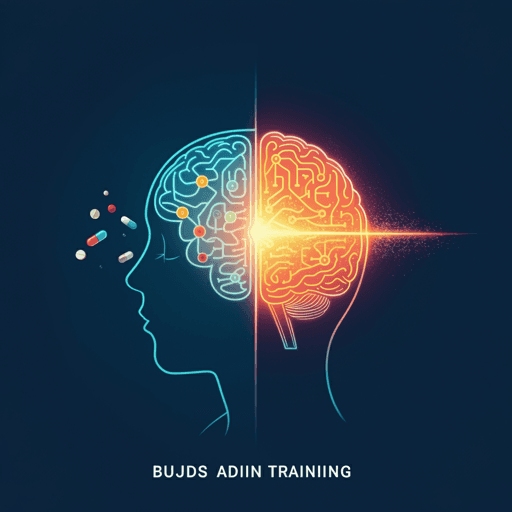
Medicine and Health
The promoting effects of digital targeted cognitive training in medication treatment for children with ADHD: a randomized controlled trial
C. Dang, Y. Zhu, et al.
A randomized 8-week trial in 124 children with ADHD compared medication alone to medication plus digitally targeted cognitive training (TCT). Overall TCT+medication did not outperform medication alone, though exploratory analyses suggest TCT may enhance atomoxetine’s effects on core symptoms and executive functions. Research conducted by Chen Dang, Yu Zhu, Xiangsheng Luo, Lu Liu, Yuan Feng, Guisen Wu, Shaogen Zhong, Xin Wang, Jianzhao Zhang, Yike Zhu, Siqi Liu, Ziqi Liu, Li Qin, Xiaohui Ma, Yufeng Wang, Xiaoyi Wang, Jian Yang, Changming Wang, and Li Sun.
~3 min • Beginner • English
Introduction
The study addresses whether adding digitally targeted cognitive training to standard medication regimens improves core ADHD symptoms and functional outcomes in children. ADHD affects approximately 6.4% of children/adolescents in China, with substantial functional impacts. While methylphenidate (MPH) and atomoxetine (ATX) effectively reduce ADHD core symptoms, their cognitive benefits—especially on higher-order executive functions—appear limited or variable. Prior meta-analyses suggest cognitive training alone yields small or non-robust benefits on ADHD symptoms and cognition, potentially due to uniform, non-individualized content that does not account for heterogeneity in ADHD-related cognitive deficits. The authors hypothesized that: (1) combining targeted, individualized digital cognitive training with medication would produce greater improvements in ADHD core symptoms than medication alone; and (2) combination therapy would improve ecological executive function, laboratory cognitive performance, and social functioning more than medication alone, with these improvements correlating with symptom reductions.
Literature Review
Medication remains first-line for ADHD, with MPH increasing striatal and prefrontal dopamine and prefrontal norepinephrine, and ATX increasing prefrontal norepinephrine and dopamine without striatal effects. Long-term studies report significant symptom improvements with both drugs. Cognitive effects of MPH show mixed findings: some meta-analyses indicate broad cognitive benefits, but dose-dependent improvements primarily in lower-order functions (baseline speed, response variability, nonexecutive memory), with limited effects on higher-order executive functions. ATX has shown symptom improvement without consistent gains in inhibitory control. Cognitive training over two decades demonstrates efficacy in selective domains, but recent meta-analyses (including trials with appropriate blinding) report limited or no effects on core ADHD symptoms, with working memory benefits attenuated when compared to semi-active controls. Heterogeneous cognitive deficits in ADHD may limit the effectiveness of fixed-component training. Combining cognitive training with medication has shown promise in other disorders and limited ADHD contexts, but no prior studies have integrated medication with digitally delivered targeted cognitive training tailored to individual deficits.
Methodology
Design: Randomized, parallel-group controlled trial; unblinded. Timeline: June 2021–December 2023. Participants: 200 assessed; 160 randomized; 124 completed 8-week intervention (TCT+M n=60; M n=64). Mean age 9.4 years (SD 1.5; range 6.0–13.7); 111 male. Recruitment: Pediatric psychiatric outpatient clinics at Peking University Sixth Hospital and Capital Institute of Pediatrics. Ethics: Approved by both institutions; informed consent obtained.
Inclusion criteria: DSM-5 ADHD diagnosis (senior psychiatrist; parent K-SADS-PL interview), IQ>80 (WISC-IV), age 6–16, medication-naïve or washed out (≥5 half-lives). Exclusion: Major psychiatric/neurological disorders, significant somatic/visual/auditory impairment, concurrent non-medication treatments.
Randomization and masking: After determining medication type (clinical decision with patient/parent/physician, considering symptoms, weight, side effects), participants randomized 1:1 to medication alone (M) or TCT+medication (TCT+M), matched on age, sex, severity. Allocation not blinded. Randomization sequence generation/enrollment/assignment conducted at respective institutions by authors.
Interventions: Duration 8 weeks. M group: MPH or ATX with titration to optimal dose over ~2–4 weeks. MPH: start 18 mg/day, adjust ±18 mg weekly, max 54 mg/day; mean end-dose 23.26±8.49 mg/day (0.67±0.19 mg/kg/day). ATX: start 0.5 mg/kg/day, adjust weekly to max 1.2 mg/kg/day or 100 mg; mean end-dose 31.25±11.71 mg/day (0.89±0.23 mg/kg/day). TCT+M group: same medication management; mean end-dose MPH 24.5±7.54 mg/day (0.70±0.18 mg/kg/day); ATX 30.75±12.11 mg/day (0.87±0.26 mg/kg/day). Concurrent digitally targeted cognitive training (developed with Beijing Wispirit Technology Co., Ltd.). Baseline cognitive assessment across domains (perception, attention, memory, executive function, social cognition) informed individualized training plans.
Cognitive training protocol: 40 sessions over 8 weeks (5 days/week). Each daily session: five tasks, 2 minutes each, repeated three times (~30 min/day). 33 tasks across five domains (3 perception; 8 attention; 9 memory; 12 executive function; 1 social recognition). Assessment tasks and training tasks used distinct paradigms within domains to mitigate practice effects. Self-adaptive difficulty adjustments every ~3–5 trials based on performance; higher scores unlock increased difficulty. Instructions provided in text/image. Parents confirmed tablet availability; physicians supervised remotely, sent reminders, and adjusted plans based on training data. Clinical appointments biweekly to monthly for medication monitoring.
Outcome measures: Primary—ADHD-RS (18 items; inattention and hyperactivity/impulsivity subscales); change scores (baseline minus post) and reduction rates ((baseline-post)/baseline). Secondary—BRIEF (parent version: GEC, MI, BRI; and eight domains), WFIRS (parent version), and 10 laboratory cognitive tasks (same as baseline). Parents completed questionnaires online; the same parent rated at both time points. Cognitive tasks administered in a quiet lab using a tablet.
Dropout criteria: Voluntary withdrawal; additional treatments; <32 training sessions (<80% of planned 40); medication discontinuation >7 consecutive days. Side effects monitored.
Sample size: A priori α=0.05, power=0.95, effect size f=0.3 → required n=136; target n=160 allowing 15% dropout (achieved). Statistical analysis: SPSS 29.0. Random-intercepts linear mixed-effects models (LMM) with fixed effects group (M vs TCT+M), time (baseline vs post), group×time interaction; random effect participant; covariates gender, IQ, age. LMM also for reduction rates. Effect sizes: Cohen’s d. Missing data: only lab cognitive tasks (N=42 missed in-person due to COVID-19 lockdowns); parent questionnaires complete. Pearson correlations between changes in ADHD-RS and secondary outcomes. Regression (Enter method) to assess baseline predictors of ADHD-RS changes; FDR correction (Benjamini-Hochberg, MATLAB mafdr) with adjusted p<0.05 considered significant.
Key Findings
Main analyses (TCT+M vs M, 8 weeks): No significant differences between groups for ADHD-RS change scores or reduction rates (all p>0.05). Examples (LSMD, 95% CI, p, FDR): ADHD-RS total change 2.30 (−0.47 to 5.08), p=0.103, FDR=0.340; inattention change 1.20 (−0.42 to 2.82), p=0.145; hyperactivity/impulsivity change 1.10 (−0.50 to 2.70), p=0.175. Reduction rates: total −4.60 (−11.74 to 2.54), p=0.204; inattention −4.54 (−12.11 to 3.10), p=0.243; hyperactivity/impulsivity −2.91 (−13.65 to 7.84), p=0.593. Ecological executive function: nominal differences in BRIEF GEC (LSMD 0.12, p=0.032) and MI (LSMD 0.16, p=0.010) did not survive FDR (0.160 and 0.100). WFIRS total LSMD 0.09, p=0.354. Laboratory cognitive tasks: no significant between-group differences.
Post-hoc exploratory subgroup analyses:
- MPH subgroup (MPH n=33; TCT+MPH n=28): No significant differences for ADHD-RS changes or reduction rates, BRIEF indices, WFIRS, or cognitive tasks (all p>0.05). Example: ADHD-RS total change LSMD −0.13 (−4.15 to 3.89), p=0.948.
- ATX subgroup (ATX n=31; TCT+ATX n=32): TCT+ATX showed greater improvements than ATX alone. ADHD-RS change scores: total LSMD 4.60 (0.78 to 8.42), p=0.019, FDR=0.042; inattention 2.38 (0.27 to 4.49), p=0.028, FDR=0.042; hyperactivity/impulsivity 2.22 (0.09 to 4.34), p=0.041, FDR=0.046. Reduction rates (%): total −12.76 (−22.05 to −3.46), p=0.008, FDR=0.041; inattention −11.23 (−20.34 to −2.13), p=0.016, FDR=0.042; hyperactivity/impulsivity −16.58 (−28.90 to −4.27), p=0.009, FDR=0.041. BRIEF: GEC LSMD 0.17 (0.02 to 0.32), p=0.031, FDR=0.042; MI LSMD 0.18 (0.01 to 0.34), p=0.033, FDR=0.042; BRI not significant (p=0.061). WFIRS and lab cognitive tasks: no significant differences. Correlations (ATX groups combined): BRIEF changes associated with ADHD-RS improvements—GEC with inattention and total (r≥0.377, p<0.05); MI with inattention and total (r≥0.400, p<0.05); hyperactivity/impulsivity correlations not significant.
Safety: Medication side effects included nausea and decreased appetite, contributing to withdrawals. Cognitive training largely well tolerated; one child experienced frustration with a maze task; training plan was personalized to exclude the task and treatment continued.
Additional observations: Average ADHD-RS reduction rates over 8 weeks favored MPH over ATX in monotherapy (e.g., total MPH≈30.4% vs ATX≈21.5%), but TCT+ATX achieved reduction rates comparable to MPH monotherapy (total ≈34.3% vs ≈30.4%).
Discussion
The primary hypothesis—that adding digitally targeted cognitive training to medication improves ADHD core symptoms and functional outcomes over medication alone—was not supported in the overall sample. However, post-hoc analyses suggest targeted training may enhance the therapeutic effect of atomoxetine, but not methylphenidate. The lack of added benefit with MPH may reflect overlapping mechanisms: MPH’s broad improvements in executive functions and widespread modulation of fronto-parietal and cingulo-frontal brain networks could overshadow or saturate the incremental benefits achievable via cognitive training. Imaging literature indicates that neural changes after cognitive training resemble those produced by MPH, potentially reducing observable additive effects. In contrast, ATX’s more selective prefrontal modulation might allow cognitive training to confer additional gains in ecological executive functioning, which in turn correlate with improvements in ADHD symptoms (notably inattention and total scores). Thus, targeted cognitive training may act as a synergistic adjunct specifically with ATX, improving ecological executive function that transfers to symptom relief. The absence of differences in laboratory cognitive tasks could be due to measurement sensitivity limitations; more sensitive neurophysiological or neuroimaging measures may better capture changes. These findings underscore the importance of individualized cognitive training aligned to each child’s deficit profile and suggest potential clinical utility for children who cannot tolerate or do not benefit from MPH.
Conclusion
This first randomized trial integrating digitally delivered, individualized targeted cognitive training with medication in pediatric ADHD found no overall superiority of combination therapy versus medication alone for core symptoms or secondary outcomes over 8 weeks. Exploratory post-hoc analyses indicate a potential synergistic effect of targeted cognitive training with atomoxetine, yielding greater ADHD-RS improvements and enhanced ecological executive functions with symptom-related correlations, but no added benefit with methylphenidate. These preliminary findings suggest a viable alternative strategy for children unable to receive MPH. Given the exploratory nature of subgroup results, rigorous, adequately powered, blinded trials with active control conditions and sensitive outcome measures are needed to validate generalizability and durability, optimize training personalization, and elucidate neurobiological mechanisms.
Limitations
- Small sample sizes within medication subgroups (ATX, MPH) limit power and generalizability.
- Some ATX-treated children titrated slowly and may not have reached optimal dose within 8 weeks, potentially attenuating ATX response.
- Only two medications (MPH, ATX) available in mainland China; adjunctive effects with other agents (e.g., guanfacine) remain untested.
- No long-term follow-up; durability of TCT+ATX effects unknown and cognitive training benefits may require longer duration.
- Outcome assessments relied on parent-rated questionnaires and laboratory cognitive tasks without neurophysiological or neuroimaging measures; potential insensitivity to neural changes.
- Lack of clinician-rated outcomes (e.g., Clinical Global Impression) in assessments.
- Unblinded design may introduce bias; future studies should implement double-blind procedures and active control (non-adaptive training).
Related Publications
Explore these studies to deepen your understanding of the subject.







